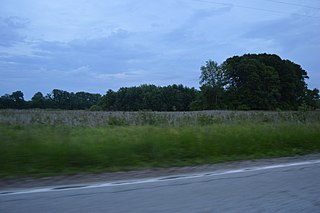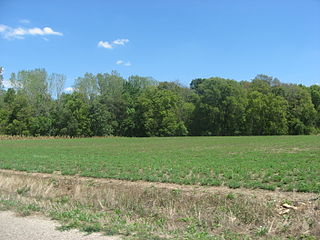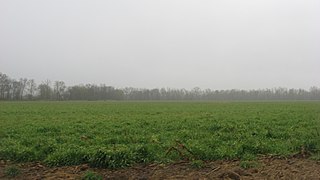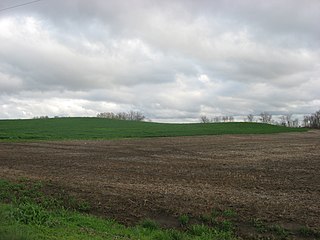Related Research Articles

Wickliffe Mounds is a prehistoric, Mississippian culture archaeological site located in Ballard County, Kentucky, just outside the town of Wickliffe, about 3 miles (4.8 km) from the confluence of the Ohio and Mississippi rivers. Archaeological investigations have linked the site with others along the Ohio River in Illinois and Kentucky as part of the Angel Phase of Mississippian culture. Wickliffe Mounds is controlled by the State Parks Service, which operates a museum at the site for interpretation of the ancient community. Listed on the National Register of Historic Places, it is also a Kentucky Archeological Landmark and State Historic Site.

The Kamp Mound Site is a prehistoric mound and village site located along the Illinois River and Illinois Route 100 north of Kampsville, Illinois. The Hopewellian site includes seven mounds dating from 100 B.C. - 450 A.D. and a village site dating from 450-700 A.D. The Havana Hopewell culture used the complex as a ceremonial and burial site. Archaeologists have also proposed that the site served as a regional trade center for the Hopewellian exchange system. The seven mounds at the site, which were originally part of a group of ten, include some of Illinois' largest mounds. In addition, large amounts of shell and animal bone fragments have been recovered from the site.

Clear Lake Site is an archaeological site located in Sand Ridge State Park 6.5 miles (10.5 km) from Manito, Illinois. The site was occupied for the majority of the period from 500 B.C. to 1500 A.D.; cultures which have occupied the site include the Early Woodland, Havana Hopewell, and Mississippian. The site consists of a village area and two burial mounds. University of Chicago archaeologists conducted the first excavations at the site in 1932. Significant further excavations were conducted by George and Ethel Schoenbeck of the Peoria Academy of Science; the couple recovered 24,000 pottery shards from the site which represent every pottery type found in Central Illinois. The Illinois State Museum, which received all artifacts recovered by the Schoenbecks, conducted its own excavations at the site in the 1950s.

The Riverton Site is an archaeological site located immediately west of the Wabash River and northeast of Palestine, Illinois. The site, which dates from the Late Archaic period, is the type site of the Riverton culture. The Riverton culture, of which only three known sites had been discovered as of 1978, inhabited the central Wabash Valley and had distinct methods of making tools. The remains at the Riverton site can be separated into two areas: a manufacturing area with pits and a significant number of discarded tools, and a residential area with the clay floors of homes. The site was first noticed in the 1950s, and Dr. Frank Winters of the Illinois State Museum began excavations at the site in 1961.

The Swan Island Site is an archaeological site in Crawford County, Illinois, located north of the point where the Wabash River crosses the Lawrence County line. The shell midden site, located on a sandstone ridge in the Wabash River flood plain, was inhabited by people of the Riverton culture in the Late Archaic period. As of 1978, it is one of three known sites associated with the culture, which lived in the central Wabash Valley and had distinct methods of making tools. Archaeologists first found the site in the 1950s, and Dr. Howard Winters of the Illinois State Museum began excavations there in 1961.

The Stoner Site is a substantial archaeological site in the far eastern portion of the U.S. state of Illinois. Discovered during the Great Depression, the site has produced large numbers of artifacts from a prehistoric village that was once located there, and archaeological investigations have shown it to be one of the area's most important archaeological sites for the Allison-Lamotte culture. After more than a decade of fruitful research and predictions of potentially rich results from future work, it has been designated a historic site.

The Eaker Site (3MS105) is an archaeological site on Eaker Air Force Base near Blytheville, Arkansas that was declared a National Historic Landmark in 1996. The site is the largest and most intact Late Mississippian Nodena Phase village site within the Central Mississippi Valley, with archaeological evidence indicating a palisaded village some 50 acres (20 ha) in size, with hundreds of structures. The site's major period of occupation was 1350–1450 CE, although evidence of occupation dates back to 600 CE. The site is also hypothesized to have been occupied by the Quapaw prior to a migration further south, after which they made contact with Europeans in the late 17th century.

The Kincaid Mounds Historic Site c. 1050–1400 CE, is a Mississippian culture archaeological site located at the southern tip of present-day U.S. state of Illinois, along the Ohio River. Kincaid Mounds has been notable for both its significant role in native North American prehistory and for the central role the site has played in the development of modern archaeological techniques. The site had at least 11 substructure platform mounds, and 8 other monuments.

Albany Mounds State Historic Site, also known as Albany Mounds Site, is a historic site operated by the Illinois Historic Preservation Agency. It spans over 205 acres of land near the Mississippi river at the northwest edge of the state of Illinois in the United States. In 1974, the site was added to the National Register of Historic Places list. The historical site is under the provision of the Illinois Historic Preservation Agency, a governmental agency founded in 1985 for the maintaining of historical sites within the state. In the 1990s, the site underwent a restoration project that aimed to return its appearance to its original condition.

Towosahgy State Historic Site (23MI2), also known as Beckwith's Fort Archeological Site, is a large Mississippian archaeological site with a Woodland period Baytown culture component located in Mississippi County, Missouri. It is believed to have been inhabited from c. 400-1350. The site is maintained by the Missouri Department of Natural Resources as a state historic site. The name Towosahgy is an Osage word which means "old town." It is not known if members of the historic Osage, who dominated a large area of present-day Missouri at the beginning of encounter with European colonizers, occupied the site. The site was acquired by the Missouri state park system in 1967 and added to the National Register of Historic Places in 1969 as NRIS number 69000113,

This is a list of the National Register of Historic Places listings in Fulton County, Illinois.

The Allison-Lamotte culture was an archaeological culture that inhabited the Wabash River valley in the United States during the later portion of the Woodland period. Flourishing approximately from AD 100 to 600, the culture's sites are common near the modern city of Vincennes, Indiana. First defined in 1963, the culture was originally described as being divided into two phases — Allison and LaMotte — although some later authors have taught a single unified phase.

The Duffy Site is a substantial archaeological site along the Wabash River in the southeastern part of the U.S. state of Illinois. Located near the village of New Haven in Gallatin County, it is the type site for the Duffy Complex, a group of similar sites on the Illinois side of the Wabash near its confluence with the Ohio River. Duffy is distinctive largely because of its pottery: the site's inhabitants typically produced ceramics of various thicknesses and comparatively few decorative elements, tempered with grog. What decorations exist are typically limited to one or two rows of simple lines or bars that have been incised or stamped on the side of the piece of pottery. Projectile points found at the site are small triangular "Mounds Stemless" points, and the inhabitants produced celts of a vaguely rectangular shape. The site is believed to have been inhabited circa AD 1000.

The Hubele Mounds and Village Site are an archaeological site in the southeastern part of the U.S. state of Illinois. Located near the community of Maunie in White County, the site has received recognition from the federal government because of its archaeological value. Due to the lack of recent excavations, the site's dates of habitation are debated, ranging from 400 BC in some estimates to AD 1000 in others, but all agree on the site's significance to understanding the prehistory of the region.

The Bieker-Wilson Village Site is an archaeological site in the far southeastern section of the U.S. state of Illinois. Inhabited during multiple periods over more than five hundred years, the village has been designated a historic site.

The Ware Mounds and Village Site (11U31), also known as the Running Lake Site, located west of Ware, Illinois, is an archaeological site comprising three platform mounds and a 160-acre (65 ha) village site. The site was inhabited by the Late Woodland and Mississippian cultures from c. 800 to c. 1300. The village is one of the only Mississippian villages known to have existed in the Mississippi River valley in Southern Illinois. As the village was located near two major sources of chert, which Mississippian cultures used to make agricultural tools, it was likely a trading center for the mineral.

The Carrier Mills Archaeological District is a group of prehistoric archaeological sites located along the Saline River south of Carrier Mills, Illinois. The sites were inhabited over the period from 2500 B.C. to 700 A.D. The oldest three sites date from the Late Archaic period, which encompassed the first 1500 years of occupation at the district; these sites include two small campsites and a larger base camp. Several sites were inhabited during the Early Woodland period, which lasted until 500 B.C.; these sites are distinguished by fragments of pottery, which was developed during this period. The Early Woodland period sites are likely to have been a part of the Crab Orchard culture, a local subtype of the Hopewell tradition. A number of sites date from the Middle Woodland Period, which spanned from 300 B.C. to 500 A.D.; these sites appear to have adopted the technology, but not the traditions, of the Hopewell culture. A single projectile point from the Late Woodland period has also been recovered from the site.

The Nutwood Site is a pre-Columbian archaeological site located on the western site of Illinois Route 100 immediately south of Narrows Creek near Nutwood, Illinois. The site dates from the Jersey Bluff phase of the Late Woodland period, which lasted from 750 to 1100 A.D. A large shell midden is located at the site; the shells were likely fished from Narrows Creek and nearby Otter Creek. Four firepits, which were identified by their concentrations of burnt limestone and igneous rock, have also been found at the site. In addition, the presence of Hopewell pottery fragments suggests that the site had connections to the earlier Hopewell culture.

The Sleeth Site is an archaeological site located near Liverpool in Fulton County, Illinois. The side encompasses a 10-acre (4.0 ha) village area including a sizable midden. The site was occupied by people of the Spoon River Culture, a local culture within the Middle Mississippian culture; it is the only known site within the Sleeth Phase of the culture and has been dated to 1500 A.D. Cultural artifacts recovered from the site include many projectile points and pottery shards from jars, plates, and bowls.
The Brewster Site is an archaeological site associated with a village of the Mill Creek culture near Cherokee, Iowa, United States. Among the items found here are ceremonial or decorative items manufactured from birds. Pottery that has been tempered with crushed granite, sand, and pulverized clamshell has also been found. The site was listed on the National Register of Historic Places in 1979.
References
- 1 2 "National Register Information System". National Register of Historic Places . National Park Service. July 9, 2010.
- ↑ Maruszak, Kathleen, and Debi A. Jones. National Register of Historic Places Inventory/Nomination: Sheets Site. National Park Service, 1978-06.